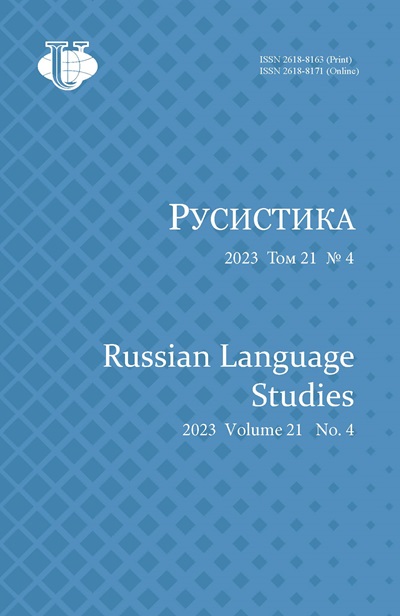THE IMAGE OF GOVERNMENT IN 1990S RUSSIAN PRINT MEDIA
- Authors: Lonskaya A.Y1
-
Affiliations:
- Peoples’ Friendship University of Russia
- Issue: Vol 15, No 1 (2017)
- Pages: 113-125
- Section: Articles
- URL: https://journals.rudn.ru/russian-language-studies/article/view/16034
- DOI: https://doi.org/10.22363/2313-2264-2017-15-1-113-125
Cite item
Full Text
Abstract
This article seeks to identify characteristic features of lexical units and phraseology used in the creation of the government’s image.This work proves relevant in that it is a careful linguistic and cultural analysis of lexical units as means of expression intended to generate emotionally colored perceptions about politicians and political situation in Russia in 1990s. The result of this study provides a thematically organized list of phraseology and lexical resources, contributing to imagery in the media texts of the period.The purpose of this work is to identify the characteristic features of the lexical units used in the texts of Russian print media to construct the state’s image.The fundamental methods of research include linguistic and cultural analysis, general scientific method (observation, description, classification, comparison), the frequency method, and comprehensive stylistic analysis. Articles concerning the activities of Russian politicians and political events that took place in Russia from 1990 to 1999 are used in this study and come from newspapers such as “Izvestiya”, “Moskovsky Komsomolets”, Nezavisimaya Gazeta”, “Pravda”, and “Zavtra”.This work allows us to conclude the feasibility of further study of the representation of government in the Russian-language media of the 1990s. This work allows the reader to conclude that the representation of government in Russian-language media during the 1990s requires further study.
About the authors
Anna Y Lonskaya
Peoples’ Friendship University of Russia
Author for correspondence.
Email: daligalia@yandex.ru
member of the National Forum of Russian language dedicated to the legacy of Academician II Sreznevsky (Ryazan, April 12-15, 2016), student-master of the department of Russian language and its teaching methodology of philological faculty of PFUR
Miklukho-Maklaya str., 10, k 2, Moscow, Russia, 117198References
- Kosmodemyanskaya K.V. Vlast i smi: vzaimodejstvie ili protivostoyanie? Teoriya i praktika obshhestvennogo razvitiya. 2014. № 4. S. 176—179. (In Russ).
- Kalmykov A.A. Chetvertaya politicheskaya sila. Vestnik RGGU. Politologiya. Socialnokommunikativnye nauki. 2012. № 1. S. 56—66. (In Russ).
- Rusina V.V. Informacionnaya politika v sfere smi v demokraticheskom obshhestve : osnovnye principy i formy realizacii v regione. M., 2005. S. 29. (In Russ).
- Fadeev A.V. Obraz politicheskoj vlasti v massovom soznanii rossiyan na rubezhe XX—XXI vekov. M., 2003. S. 20. (In Russ).
- Burova Y.E. Informacionnye resursy vlasti kak instrumenty translirovaniya eyo obraza. Gumanitarnyj vektor. Istoriya, politologiya. 2013. № 3. S. 135—139. (In Russ).
- Volkov A.I., Pugachyov M.G., Yarmolyuk S.F. Pressa v obshhestve (1959—2000). Ocenki zhurnalistov i sociologov. Dokumenty. Moscow: Izdatel’stvo moskovskoj shkoly politicheskix issledovanij, 2000. S. 616. (In Russ).
- Markov E.A. Vlast i smi v rossii: istoriya vzaimodejstviya. Izvestiya rossijskogo gosudarstvennogo pedagogicheskogo universiteta imeni A.I. Gercena. 2010. № 123. S. 204—213. (In Russ).
- Kravcov V.V. Innovacionnaya zhurnalistika i vlast v sovremennom medijnom prostranstve. Moscow, 2012. S. 52. (In Russ).
- Abramova GA Stilevoe mnogoobrazie v sfere pechatnyx smi. Kultura russkoj rechi: materialy v mezhdunarodnoj nauchnoj konferencii. 2007. S. 114—117. (In Russ).
- Klushina N.I. Semanticheskie i stilisticheskie izmeneniya v leksike sovremennoj gazety (na materiale gazet 1989—1994 gg.). Moscow, 1995. S. 25. (In Russ).
- Solganik G.Y. Tolkovyj slovar. Yazyk gazety, radio, televideniya. Moscow: Astrel’, 2004. S. 752. (In Russ).
- Ferm L. Zaimstvovaniya i inoyazychnaya leksika v yazyke gazety. Slovo. Tom 41. 1992. S. 83—109. (In Russ).
- Sklyarevskaja G.N. Tolkovyj slovar russkogo yazyka konca XX veka. Yazykovye izmeneniya. St. Petersburg: Foliopress, 1998. S. 700. (In Russ).
- Aznabaeva A.R. Evolyucionnye processy v yazyke regionalnyx sredstv massovoj informacii konca XX — nachala XXI vekov. Ufa, 2010. S. 24. (In Russ).
- Annenkova I.V. Yazyk sovremennyx smi kak sistema interpretacii v kontekste russkoj kultury (popytka ritoricheskogo osmysleniya). Yazyk sovremennoj publicistiki. Moscow: Flinta, 2007. (In Russ).
- Gorbanevskij M.V., Karaulov Y.N., Shaklein V.M. Ne govori shershavym yazykom: o narusheniyax norm rechi v elektronnyx i pechatnyx SMI. Moscow: Vysshaya shkola, 1999. S. 300. (In Russ).
- Surikova T.I. Yazyk sovremennoj pressy. Vestnik moskovscogo universiteta. Zhurnalistika. 1991. № 4. S. 81—85. (In Russ).
- Vorobev V.V. Lingvokulturologiya: teoriya i metody. Moscow: Izdatel’stvo rossiiskogo universiteta druzsbi narodov, 1997. S. 336. (In Russ).
- Shaklein V.M. Lingvokul’turnaya situaciya i issledovanie teksta. Moscow: Obshchestvo lyubitelej rossijskoj slovesnosti, 1997. S. 184. (In Russ).
- Shaklein V.M. Lingvokulturologiya. proshloe. nastoyashhee. Budushhee: monografiya. Sanfrancisco: b&m publishing, 2013. S. 320. (In Russ).
- Shaklein V.M. Lingvokulturnaya situaciya v sovremennoj Rossii. Moscow: Flinta, 2010. S. 147. (In Russ).
- Kostomarov V.G. Yazykovoj vkus epohi. Moscow: Zlatoust, 1999. S. 302. (In Russ).















